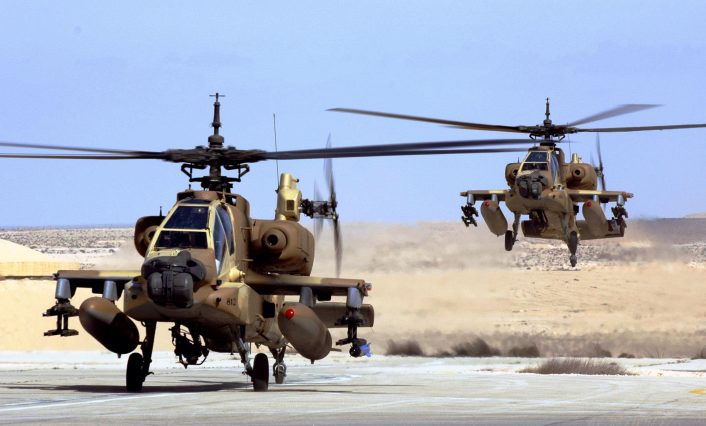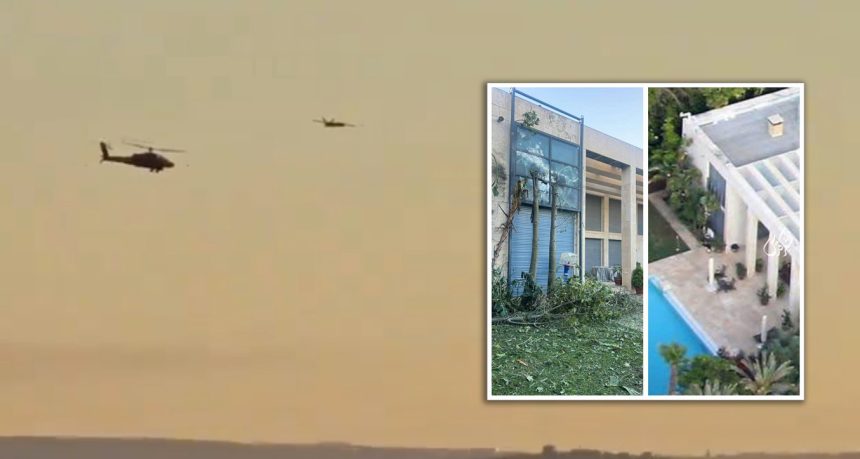Three drones crossed the border from Lebanon to Israel, with two intercepted and one hitting a house in Caesarea while Netanyahu was not at the location. It’s not clear if the building hit by the drone is part of the PM’s residence.
In the early morning of Oct. 19, 2024, three drones were launched from Lebanon into Israel, according to the Israeli military, with one hitting a building in Caesarea. Prime Minister Netanyahu’s office later released a statement saying that one of the drones was “launched towards” his house while he and his wife were not at the location.
It is unclear if the building damaged by the drone is part of the Prime Minister’s residence. Netanyahu has two private residences, one in Jerusalem and the other in Caesarea, a coastal town in northern Israel which is used as a holiday home.
There were no casualties reported, according to the Israeli ambulance service, and the police said explosions were heard in Caesarea. So far, the attack has not been claimed by Hezbollah. The other two drones were intercepted by the IDF, with videos showing an AH-64 Apache attack helicopter in pursuit of one of the drones.
Additional Footage of the Hostile Drone which was spotted earlier over Northwestern Israel, near the Cities of Haifa and Acre. pic.twitter.com/MaNYArsMPu
— OSINTdefender (@sentdefender) October 19, 2024
The incident follows the death of Hamas’ leader Yahya Sinwar this week, killed by IDF troops in Gaza. Sinwar was considered responsible for the massacre of Oct. 7, 2023. His death, however, does not appear to have changed the situation, with ran’s supreme leader, Ayatollah Ali Khamenei, saying that Hamas will carry on despite his killing.
Yahya Sinwar’s Death
Israeli forces in Gaza killed Hamas leader Yahya Sinwar, defined as the mastermind behind last year’s attack on Israel that triggered the war. According to the reports, troops appear to have come across him unknowingly during a battle, only to discover later that a body in the rubble was Israel’s most wanted man.
Israeli leaders celebrated his killing, just over a year after militants killed some 1,200 people in Israel and kidnapped 250 others, urging the group to surrender and release the estimated 100 hostages still in Gaza. Hamas has proved resilient to the death of its leaders in the past and the fight is still continuing today in Gaza.
Prime Minister Benjamin Netanyahu said that “Hamas will no longer rule Gaza. This is the beginning of the day after Hamas.” Netanyahu added that Israel will keep fighting until all the hostages are free, and that it will keep control over Gaza long enough to ensure Hamas does not rearm.
U.S. President Joe Biden said Sinwar’s death opens the way for “a political settlement that provides a better future for Israelis and Palestinians alike.” He said he would talk with Netanyahu “to discuss the pathway for bringing the hostages home to their families, and for ending this war once and for all.”

Sinwar has been Hamas’s leader inside the Gaza Strip for years and was elevated to the group’s top leadership position in July. In recent months, Israel has eliminated a string of senior figures from both Hamas and Hezbollah with airstrikes, although Sinwar was found by chance.
In fact, Israeli military spokesperson Rear Adm. Daniel Hagari said that Israeli forces identified three Hamas militants running from building to building in Gaza’s southernmost city, Rafah, on Oct. 17. The troops attempted to shoot them before they ran inside a building.
A drone, whose video was later released, was sent to recon the building and showed a man in a chair, with his face covered, in the middle of a room wrecked by shelling, throwing a stick at the drone. The military then fired an additional shell at the building, causing it to collapse and killing Sinwar. According to the IDF he was found with a bulletproof vest, grenades and 40,000 shekels ($10,707).
Sinwar’s identity was confirmed by dental records, fingerprints and DNA tests. Sinwar was imprisoned by Israel from the late 1980s until 2011, and during that time he underwent treatment for brain cancer, leaving Israeli authorities with extensive medical records.
The AH-64 Apache in the counter-drone role
The Israeli Defense Forces have been at the forefront of developing and deploying advanced counter-drone technologies, with the AH-64 Apache helicopter playing a crucial role in these efforts. In fact, the AH-64, known for its versatility and firepower, has been often employed to meet the unique challenges posed by unmanned aerial vehicles (UAVs), particularly in the context of modern asymmetric warfare.
An AH-64 “Apache” Attack Helicopter with the Israeli Air Force conducting a Successful Interception of an inbound Hezbollah Attack Drone, this morning over Northern Israel. pic.twitter.com/1l2fcBYNYS
— OSINTdefender (@sentdefender) August 25, 2024
Israel has been using the Apache in the counter-UAV role for years now. While the helicopter was equipped with an air-to-air capability based on the FIM-92 Stinger IR-guided missile, the AGM-114 Hellfire missile and 30 mm cannon have been used with success against drones.
The U.S. Army has shown interest in this capability, showcasing an AH-64D shooting down a tart drone during the recent Red Sands exercise in Saudi Arabia. The video released on that occasion showed the Longbow-equipped helicopter launching a possibly modified AGM-114L at the target.
. @USArmy Soldiers engage an unmanned aerial system (UAS) from an AH-64 with upgraded Hellfire missile during Red Sands training exercise in the Kingdom of Saudi Arabia. @usarmycentral pic.twitter.com/HG9ChuWxt6
— U.S. Central Command (@CENTCOM) September 30, 2024
The Longbow radar, also used by Israeli Apaches, is used to track the drones, cueing the Target Acquisition and Designation System (TADS) to the target and prepare for the engagement.









